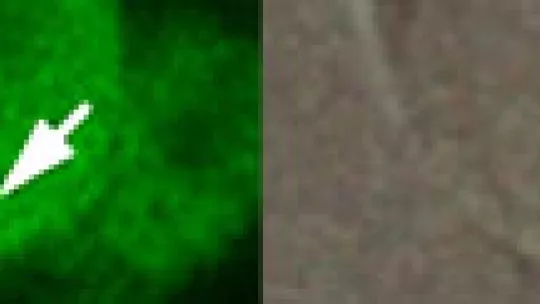Images
New research by the team of Cayetano González, ICREA research professor at IRB Barcelona, has shown that centrosomes, cell components that play a critical role in cell division, are not randomly distributed between daughter cells when stem cells divide, but follow a specific pattern. Their work, published in Nature Communications, sheds new light on our understanding of the molecular and cellular mechanisms that govern stem cell division and on the understanding of some human diseases such as cancer.
Stem cells are non-differentiated cells that, through a process of asymmetric cell division, produce two completely different cells: a stem cell that is identical to the original one and a differentiated cell with a specific function in the organism. This particular division strategy allows stem cells to self-renew, and also permits the production of large amounts of tissue during development or the regeneration of tissue that has been damaged. When this tightly regulated cell division process gets thrown off balance, tumors can form. Studies like this one may therefore be key to helping researchers understand the molecular basis of some human diseases.
More information on stem cell division
Before cells divide, the centrosomes - components that organise the cell skeleton - must, like DNA, duplicate so that each daughter cell may receive its own set. They replicate in such a way that they produce an older (“mother”) and a younger (“daughter”) set. “Other groups have shown that when centrosomes are removed from stem cells, these cells divide symmetrically and can produce tumours, and these results show that centrosomes play a crucial role in asymmetric division”, explains Januschke, a member of González team and first author of the study.
To look into how centrosomes are distributed during the asymmetric division of stem cells, the scientists used non-differentiated cells, called neuroblasts, from the brains of Drosophila melanogaster larvae. Using photo-conversion of a centrosome protein, a technique that allows monitoring the age of centrosomes during experiments by measuring fluorescence over time, the researchers found that, contrary to what happens in Drosophila male germline stem cells or in stem cells of the developing rodent nervous system, the daughter cell inherits the mother centrosome, while the stem cell gets the daughter centrosome. These findings indicate that inheritance of these organelles is not haphazard but that it follows a set pattern. Exactly why this happens, and what purpose it serves, is still unknown.
In an independent approach, the scientists applied “photo-conversion” to study a protein similar to the human protein Centrobin, a specific marker of daughter centrosomes in vertebrates. Consistent with the previous photo-conversion results, Centrobin-labelled centrosomes were systematically retained by the stem cell upon each division. “We have obtained for the first time a specific marker of daughter centrosomes in Drosophila. This achievement will allow us to further our understanding of this pattern in stem cell division”, says Januschke.
Reference article:
Drosophila neuroblasts retain the daughter centrosome
Jens Januschke, Salud Llamazares, Jose Reina, Cayetano González.
Nature Communications (2011) [doi: 10.1038/ncomms1245]
About IRB Barcelona
The Institute for Research in Biomedicine (IRB Barcelona) pursues a society free of disease. To this end, it conducts multidisciplinary research of excellence to cure cancer and other diseases linked to ageing. It establishes technology transfer agreements with the pharmaceutical industry and major hospitals to bring research results closer to society, and organises a range of science outreach activities to engage the public in an open dialogue. IRB Barcelona is an international centre that hosts 400 researchers and more than 30 nationalities. Recognised as a Severo Ochoa Centre of Excellence since 2011, IRB Barcelona is a CERCA centre and member of the Barcelona Institute of Science and Technology (BIST).





